#there was a demo too but his pose was heavily influenced by another artist so i thought it was courtesy to not upload that
Explore tagged Tumblr posts
Text
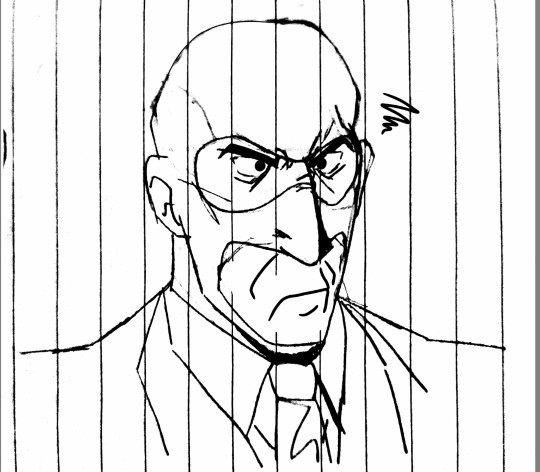
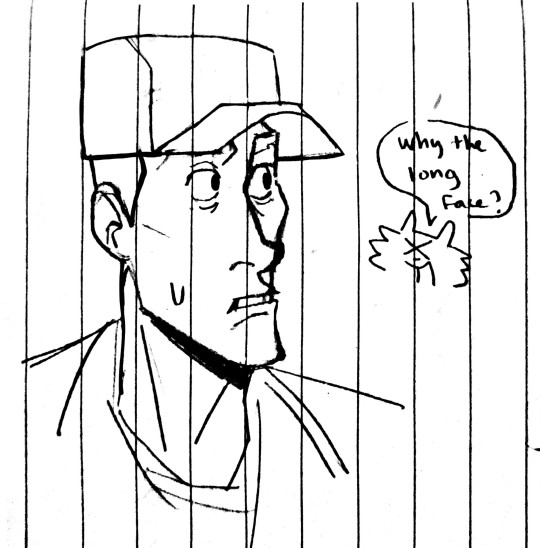
traditional doodles >_<
#my art#team fortress 2#tf2#spy tf2#scout tf2#i usually only post fully completed digital stuff but thought i'd change the formula with this#there was a demo too but his pose was heavily influenced by another artist so i thought it was courtesy to not upload that#anyways. see you guys during the next blue moon! (nah jk see you all whenever)
114 notes
·
View notes
Text
Character Design - Anatomy and Robot Design Research - 28th of December
For this research section for my character, I thought I looked at body anatomy and robot designs online to help with my research for the character design project. This will mainly help to look at not only interesting robot designs that I can help towards my research, but also think about functionally how and mechanically would these parts work and how could I carry this over into a CG model-making process.
To start off with, I began to look into anatomy online like the different types of body forms as well as looking into muscles and bones for humans as this would help me with my visual library in coming up for ideas for my characters as well as helping me out later for my silhouette designs/drawings later on. I first looked at different body language in not only in a design sense but also posing wise too as one of the criticisms with my turnaround previously was how stiff the character looked as it didn’t have any flow to the character. This is why I didn’t just look at body shape but also something called contrapposto flow which shows how you can give flow to a model/character in a standing pose using Michelangelo’s statue as reference. Through just exaggerating in areas like the shoulders and ankles by titliting them, you create a more true to life character on screen than a character that’s standing in an A-pose that gives freedom to express which can also in term describe the character from just looking at it. Learning this, I understand the comments from the tutorial a lot better as this creates a much more dynamic and varied pose that allows you to understand the character better.
Body Form Diagram
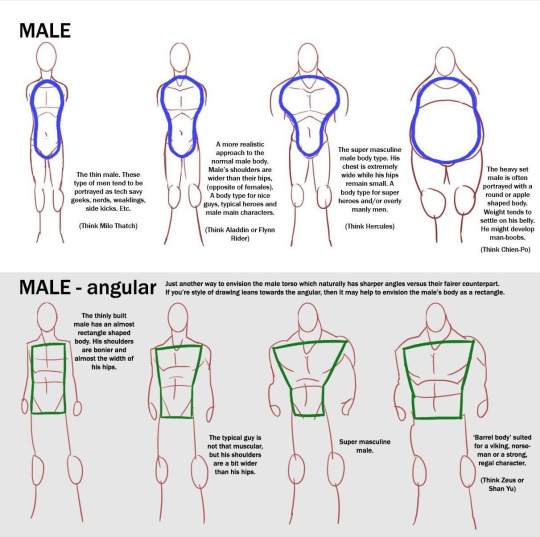
Michelangelesque Contrapposto

After this, I then did some research on bones and muscles in the human anatomy as I felt inspired from one of my favourite artists of all time (Igor Verniy) as one of his projects led to him combining human bones with scrap metal and mechanical parts he found in a scrapyard to create these really disturbing but gorgeous looking sculptures.
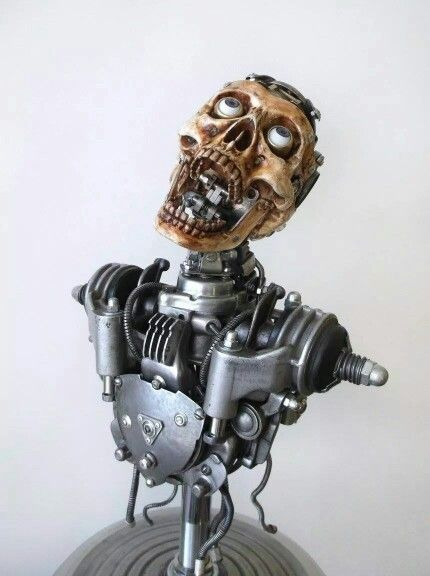

Because of his artwork, it influenced me to look down this path of bones with technology which a video I found online really helped solidified what I wanted to do for the Hyde character’s design. From casually browsing on Youtube, I stumbled across a video of a deer snorting in the cold where visibly you can see the cold mist fly out of it’s nostrils. Because of this detail, it clicked in my head that I wanted to base my Hyde character using a Deer head as the basis for the design which linked in with Igor Verniy’s work, influenced me to look into trying to make a deer’s skull incorporated with technology. This was because I could imagine a mechanised deer that is collectively made from scrap and bone that is collected from the ground to help build up this monstrous beast as well as smoke snortling out of the deer’s nostrils.
Whitetail Buck Encounter With a Serious Snort || ViralHog
youtube
Because of this new revelation, I began to research into two different types of mood boards for the Hyde character with one looking at deer heads and skulls and ideas for the Hyde character based off my deer prompt. Starting with the first mood board, I wanted to look at the designs of the antlers and the skulls as I plan to use these as a base for the head of the character and maybe design aesthetics for the body too. Two images I really love are the more metallic deer skulls and the real skulls with their large teeth as the teeth aesthetically is something I might enhance on the characters deign as well as the metallic skull of a deer as i’m looking to experiment in both fully metallic skulls and a cross between the middle.

For the the second mood board, I came across a scandinavian folklore called a Kyrkogrim which is a deity that often protects christian churches and they’re grounds from people that want to try and harm it. From this, I found that there could be symbolism from the folk tale could be implemented between the characters as Hyde while his methods are outlandish and brutal is all in all trying to protect his smaller vessel from straying away from his self and losing his identity. Researching the Kyrkogrim online, I found a lot of depictions of the creature being very human like but having a deer like head for its appearance which I was particularly fond of ‘Specimen 8′ from Spooky’s house of Jumpscares (the deer deity on the left of the mood board) as I love his creepy design to him from the antlers to his long and elongated cloak flowing down his body. I think if I was to create him more nuclear, it would be the main basis of where I would want to be taking forward with the character. In addition to looking at the Kyrkogrim, I also looked at the designs of the Wendigo as it’s another piece of folk-lore that I was inspired by as it also contains these deer like creatures in its depecitions. In addition to the folk-lore research, I looked into big bulky character designs mostly of the mechanical nature as the character is going to be made up of scrap metal lying across the ground which I instantly gravitated towards the bottom robot design for it’s cluster of colours and unproportionate shapes.
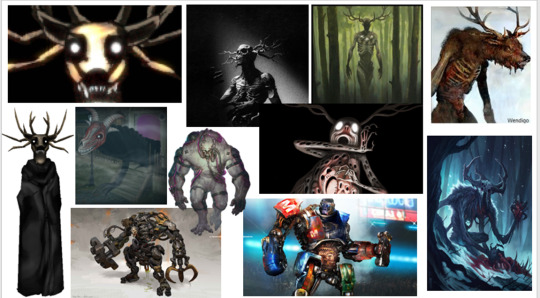
Through doing research on robots, I look into few images of real life robots that are made today and see how mechanically they work as well their design aesthetic. In addition too, I looked into robots built up from scrap metal for references and compare in visuals against the real life robots.
I first started off researching looking at robotic movement to see how morden robots have evolved in their articulation. This is where I stumbled across this video where a robot can simulate human movement in its body. Whilst not a fully autonomous robot that moves itself, understanding its movement was really fascinating to watch from how jittery but also smooth the movements were from the arms, legs and body of the robot were but quite strange at the same time with details like the legs and hands being so stiff in places. The design of the robot was something that really struck me as they use a lot of smooth and curved panels to hide the electronics of the robot but also have exposed areas in the arms and legs like wires and bolts.
This Humanoid Robot Can Mimic Human Movement In Real Time | Mach | NBC News
youtube
From this first bit of research, this then led me to the Boston Dynamics Youtube channel where their most recent video showcases all of their most developed robots dancing to the song ‘Do you Love Me’. I was completely mesmerised by the animation and how in sync they were all in together especially for something that's been made today. The main highlight was how each robot had their own style of movement to them giving them a different personality as they danced. The robot people acted jittery and stiff but somehow smooth with the dog and crane robots much smoother but much more limited in flexibility compared to the human based robots. Overseeing the robots dancing and watching a few more of the other demos of the robots opening doors and doing stunts, they have a very slow and jittery movement to them before they do a really quick action like they’re building up energy for the action. This is definitely more seen in the human based robots as the non-human like ones operate movement is a lot smoother but often hold a position/stance before a next move is made.
In terms of design, they almost follow the same principles to the Toyota robots with the smooth white panel design to them with loose cables visible to the eye. However I prefer these robots to the Toyota ones very greatly as their visuals are more the kind of design I want to imagine for my Hyde character as they may have the protective panels on the more sensitive parts of the robots so they aren’t damaged, the loose cables and the exposed mechanisms that can be seen are so up my street for the character as it gives it a very futuristic look to it without looking too smart which what modern robots tend to look like. This is mostly shown in the human based robots that Boston Dynamics have made as the dog and crane are designed to have no protective panels or completely protective. Not this is a problem as both of their designs I really enjoy as I love the smartness of the dog looking robot and the complex and technical nature of the crane as they complement each other really well from how they move.
Do You Love Me?
youtube
Hey Buddy, Can You Give Me a Hand?
youtube
What's new, Atlas?
youtube
Images from the ‘Do you Love me’ video by Boston Dynamics
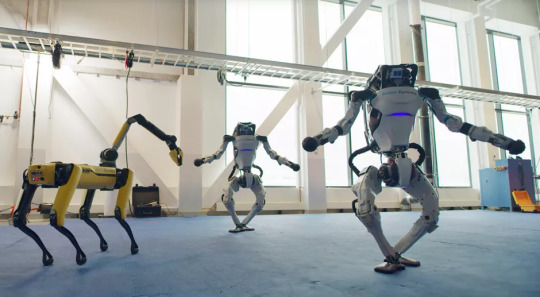

After the Boston Dynamics research, I then looked into scrap/junk based robot designs on the internet as that's how I imagine the Hyde character to look like when I will design him. Going back to when I was first thinking about the character in this blog post. the character ‘Metro’ from the film ‘Reel Steel’ is the the exact direction I would want to take with this character and possibly for the render style too. This is mostly from the irregular shapes that have been attached to the design like they’ve been randomly placed on the character in a frankenstein sort of fashion to the character which would work really well with my Hyde character as he gathers bits and bobs collectively around his surroundings. Going back to variety, I love how the arm joints are constructed here as its on a three ball hinge but being really exposed compare to the other arm which is heavily built too. I think from observing this design, I want to do a cross between irregular shapes on the characters design in addition to the smart looking design of the Boston Dynamics robots. Essentially, a fusion between Reel Steel’s Metro and Boston Dynamics Human-like robot is what my Hyde character should look like with deer elements inspired for the character.

Below is the mood board I also created when looking into the scrap aesthetic and creating a scrap robot of some kind. Like with ‘Metro’, i wanted to focus on irregular shapes for the Hyde character as this is how I imagine he's going to be built up which I looked at character which were not inherently bulky but more going along that brief. With the top right image in the corner of this mood board, it uses an excellent use of these irregular shapes with bits of metal sticking out of the body. Another thing I like from these mood board images is that I’ve looked at a variety of both bulky and thin character designs as they use different ways to build up the metal and parts to make the character like the one on top with the purple background being comprised of one solid object compared to the one below it with different parts scattered across the design with different patterns.
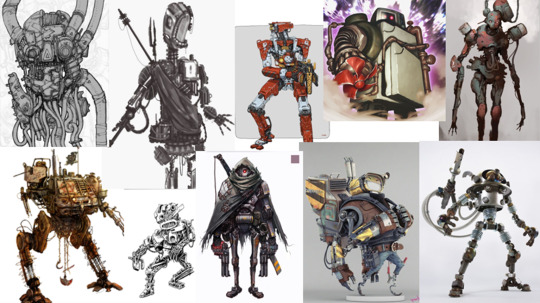
Looking back on my research over these couple of days, I’m really happy from my findings as not only have I developed my understanding on the themes for my characters but also coming with new ideas and visuals that I can work from to make a final design for my characters. I think my favourite part of my research was looking up the deer-related content for the Hyde character as I ended finding a lots of cool references dwelled into like the Kyrkogrim and looking at modern day robots like the ones from Boston Dynamics. Their design of the panels being spaced out is something I would really love to incorporate into the character with loose cables and mechanisms being exposed to the eye.
1 note
·
View note
Text
Bryan Ferry on how Roxy Music invented a new kind of pop: 'We were game for anything'
More than 45 years ago, a new group released their first album. They didn’t wear denim, nor had they, apparently, paid their dues. Indeed, their heavily stylised presentation – a model posed archly on the cover in a 1950s pastiche, the musicians inside clad in leopardskin and leather with styled quiffs – could not have been more opposed to the rock modes of the day. “Is this a recording session or a cocktail party?” inquired Ferry’s friend Simon Puxley in the liner notes. Before you even got to the music, the record cover was a gauntlet thrown down – an explosion of glamour in a wasteland of faded blue cotton.
“The clothes we were wearing at that time would have put off quite a large chunk of people,” reflects Bryan Ferry. “What I liked about the American bands, the Stax label and Motown, they were into presentation and show business, mohair suits, quite slick. And the cover art, I thought of all the American pop culture icons, Marilyn Monroe: selling cigarettes or beer with a glamorous image. But it was a bit off-kilter as well; there was something a bit strange about it, futuristic as well as retro. All that, instead of a picture of the band, in a dreary street, looking rather sullen. Which was the norm.”
Timeline
Bryan Ferry: his career highlights
1971
Roxy Music form
Bryan Ferry was working as a ceramics teacher in a girls' school after leaving art school in Newcastle, having already played with Roxy bassist Graham Simpson in the band the Gas Board. They began amassing band members, including Brian Eno, eventually recruiting the final piece of the Roxy puzzle, guitarist Phil Manzanera.
1973
For Your Pleasure
Roxy Music's self-titled debut was a hit, as was this second album, which reached No 4 in the UK. It would be the last album with Eno, and features some of Ferry's most evocative performances, from the debonair strut of Do the Strand to the creepy In Every Dream Home a Heartache.
1974
Love is the Drug
Love is the Drug, from the Country Life album, is perhaps the most enduring Roxy hit – an irrepressible disco stomp, with Ferry peacocking through it with a magnificent staccato delivery. It was the band's only US hit, and reached no 2 in the UK.
1976
Let's Stick Together
During a two-year Roxy hiatus, Ferry released a pair of solo albums, with the title track from Let's Stick Together hitting the top five. It's a cover of the blues song by Wilbert Harrison, and Ferry has proven adept at covers down the years – his debut solo album in 1973 featured versions of everything from Piece of My Heart to Sympathy for the Devil, while Roxy Music's cover of John Lennon's Jealous Guy became the band's only No 1 single.
1982
Avalon
The final Roxy Music album was a long way from the fiendishly psychedelic art pop of their first records – it helped define the slick sound of 80s soft rock with tracks such as More Than This. It was released a month before his wedding to Lucy Helmore, a marriage that lasted until 2003.
1990
Fourth son Merlin born
Ferry has four sons: Otis, Isaac, Tara and Merlin. The latter survived a terrible car crash in 2014, while Otis became infamous for his support of fox hunting.
2001
Roxy Music reform
Roxy Music reformed for their 30th anniversary, and went on to tour in 2005, 2010 and 2011. Ferry continued to release solo work, including more cover versions – an album of jazz standards, As Time Goes By, was followed by an album of Dylan songs, Dylanesque.
2010
Olympia
After teasing new Roxy Music tracks for a number of years, including sessions with Eno, Ferry released the songs on his solo album Olympia, which also features Nile Rodgers, David Gilmour, Johnny Greenwood and Flea – plus Kate Moss on the cover.
Thank you for your feedback.
The music inside lived up to the cover’s challenge: a collage of pop-culture nostalgia, hard-rock guitar, piano-driven melodies, stylised high vocals, strange musical structures and experimental sound pictures. Roxy Music’s eponymous album sounded like nothing else in 1971 and 1972 – and like nothing else the group would ever attempt again. Recorded in the first full flush of inspiration, songs such as Ladytron, The Bob (Medley), and Sea Breezes exist outside of their time: a radical synthesis that mapped the future at the same time as it plundered the past.
Watch Roxy Music performing Ladytron on The Old Grey Whistle Test in 1972
“We were definitely trying to show our versatility,” says Ferry now. “I had lots of musical influences, plus what the band brought to the table.” Lead guitarist Phil Manzanera, he says, “had this Latin heritage, being born in South America”. Saxophone and oboe player Andy Mackay was classically trained. “[Brian] Eno with his deep interest in experimental music. They were specialists in their field. Paul Thompson brought a lot, with his very powerful, earthy drumming, which was one of the features of the Velvet Underground.”
The cover of Roxy Music immediately marked it out from the rest of 1972’s fare
Ferry is talking in his west-London studio. We walk past repeated Warhol Marilyns and sit under a large print of Jerry Hall on the north coast of Anglesey, the cover for Roxy Music’s fifth album, Siren. Wearing a blue jacket, V-neck pullover and tie, Ferry is measured, at once diffident and supremely assured. At 72, he looks great. “The only bit I don’t like is analysing it,” he says of his work. “I do sometimes envy the people who don’t ever have to describe what they’re doing.”
Despite its age and apparent familiarity, Roxy Music’s debut remains thrillingly strange. A new reissue, eight years in the making, traces the development of this revolutionary record that seemingly arrived out of nowhere in June 1972. Combined with the group’s first, 1971 demos, three 1972 John Peel sessions and album outtakes, the songs that would populate Roxy Music come into focus as the bold, honed culmination of lifelong fixations.
Growing up in Washington, County Durham during the monochrome 1950s, Ferry found a lifeline and an inspiration: “I loved American music,” he says. ““From the age of about 10, every week you’d discover somebody new. I was very much into jazz. You know how English people are; there’s a certain amount of musical snobbery. I mean, I loved Little Richard and Fats Domino, but when I heard Charlie Parker for the first time, this was something I really loved, and nobody else who I knew knew anything about him. It’s good to have your private obsessions.”
Roxy Music photographed at London’s Royal College of Art, July 1972 (from left): Phil Manzanera, Bryan Ferry, Andy Mackay, Brian Eno, Rik Kenton and Paul Thompson. Photograph: Brian Cooke/Redferns
As a paperboy delivering newspapers and weekly music magazines, Ferry read about more music than he could actually hear. “There wasn’t a great deal of jazz on radio. Radio Luxembourg was very important for emerging pop and soul. The BBC had one or two programmes. When the skiffle thing happened, that was when you started hearing Leadbelly and Big Bill Broonzy. That intensity of feeling; that’s what I got, hearing Leadbelly with a 12-string guitar, that yearning in his voice, it struck such a magical chord in me.”
He had similar revelations from hearing Lotte Lenya singing the songs of her husband Kurt Weill and the German soprano Elizabeth Schwarzkopf singing Richard Strauss’s Four Last Songs, He loved the beat poets, TS Eliot and American show tunes. “I liked Fred Astaire, Cole Porter, and I’d hear those songs played by Charlie Parker, Lester Young, Billie Holiday. There was a music store in Newcastle where you could go into a booth and listen to stuff. I lived in there.”
While in the sixth form at Washington Grammar, Ferry joined a group called the Banshees, who played R&B in the local clubs – including the famous Club A Go Go that had provided the launch pad for the Animals. In autumn 1964, he entered the fine art department of Newcastle University, where he was inspired by the British pop-artist Richard Hamilton and Warhol associate Mark Lancaster. After completing his degree, Ferry moved to London, where he supported himself by teaching art and ceramics at a Hammersmith school.
Roxy Music began in the late 1960s, after this move to the capital. Having sung R&B and soul with groups such as the Gas Board and the City Blues, he began to pursue the idea of striking out on his own. “In my college band, I had been imitating whichever song I was singing. We used to do quite obscure covers – Bobby Bland, BB King – but by the time I was writing my own songs, I didn’t want to sound too American. At the time, most English bands tried to sound American. Except for people like King Crimson. They had an English voice, which was quite interesting.”
He was convinced that he could start his own band. “First of all, [it was] just me and Graham [Simpson], the bass player. He had been in my college band. He was a very cool guy, into the beat poets, had a huge jazz collection, all those Blue Note records. He was one of the most interesting people in the band, actually. Sardonic sense of humour. Then Mackay, next, then Eno.”
Another early shot of Roxy Music from 1972. Photograph: Brian Moody/Rex Features
Each new addition brought an element that enabled the new group’s individuality. “The oboe was Andy Mackay’s first instrument, his main thing, although he developed into a great sax player. I met Andy because he had a synthesiser. So Andy brought a) the synthesiser and b) the oboe. Eno, of course, manipulated the synth in the band as soon as he joined, really. Those textures: the oboe is very precise, and the synth sounds were washes, colours, textures, mood enhancers, and so on. So, yes, it was a key part of the sound.”
Together with first guitarist Roger Bunn and drummer Dexter Lloyd, Roxy Music recorded their first demos in May 1971, early versions of The Bob (Medley), Grey Lagoons, 2HB, Chance Meeting and Ladytron. “They were all done in Eno’s flat in Camberwell, which is where we ended up doing a lot of rehearsals. There was a derelict house off Portobello Road where we went as well. That’s when it started. I thought of nothing else, I was quite driven to make it all happen. I would carry the tape around to record labels on my days off from teaching.”
A key early supporter was Richard Williams, who featured the group in Melody Maker during august 1971 before they had any whiff of record company interest. Williams had written glowing and informed reviews of, among other things, the recently reissued first three Velvet Underground albums, which piqued Ferry’s attention. “I always seemed to agree with his taste. So I thought, if anyone is going to like my music, it’s going to be this guy, so I sent him the tape. And he phoned me the same day to say how much he liked it.”
Slowly Roxy Music came into their time. With their Velvet Underground influence, they were tapping into similar sources to David Bowie. But the connections went deeper, into the Warholian fusion of pop and art – an approach prompted by Ferry’s friendship with Lancaster, who had worked in the Factory as a screen-printer in the mid-60s. “He was a really influential guy for me. He was the link between us and Richard Hamilton. All of those people were very influential, working with pop imagery.”
Ferry in 1973. Photograph: Ian Dickson / Rex Features
It was Roxy Music’s explicit intention to dissolve the boundaries between high and low. As Michael Bracewell writes in Re-make/Re-model, his account of the group’s founding years, “they chose to inhabit the point where fine art and the avant garde met the vivacity of pop and fashion as an almost elemental force in modern society”.
Produced by King Crimson lyricist Pete Sinfield, Roxy Music came together over two weeks in March 1972. The range of material is extraordinary: almost every song contains sudden twists and turns, like the galloping Joe Meek-style descent that comes out of nowhere in Ladytron. The opener, Re-Make/Re-Model, begins in party noises and breaks into brief, emblematic solos from each instrument. In Sea Breezes, synthesiser washes introduce a heartfelt torch song, which then segues into a strangulated guitar part: next up is the cocktail doo-wop of the tart album closer Bitters End.
“A lot of the first album is first or second take,” Ferry remembers. “Thinking about the songs, some of them are collage-like, with different sounds and moods within them – they will change abruptly into something else. For instance, Sea Breezes is a slow song, and suddenly moves into this angular, quite opposite mood. I found that interesting, and this band was perfect for that; they were game for anything. We were constantly fiddling around, changing things. I was still trying to find my voice. I [now] think sometimes I’m singing too high, or I should have had another go at that.”
It would have been easy to write Roxy Music off as pastiche – as a few die-hard hippies did at the time – but the feeling is authentic: the love, loss and regret in songs such as If There is Something, Sea Breezes and The Bob (Medley). It’s an album of chance encounters and wistful, evasive memories. “On one hand, you try to shape the emotion, but you’ve got to feel it,” says Ferry, “you don’t analyse as you’re doing it.”
Released in the same week as Ziggy Stardust and the Spiders From Mars, Roxy Music entered the UK album charts in late July 1972. Within a month, the group’s first single, Virginia Plain, which wasn’t on the album, was on its way to the Top 10 (it reached No 4). Referencing an art college painting by Ferry, it distilled Roxy’s art-pop manifesto, “what’s real and what’s make-believe”. “It is much more confident,” Ferry says. “We’d made an album and we knew how to do it – sort of. Everyone was featured. It had oboe, the synth, the drums are powerful, and the lyrics were much more assured. I was still finding my feet as a songwriter.”
Roxy Music: 10 of the best
Roxy Music had no sense that the album would reach a mainstream audience. “We thought art students; people like us; limited interest; underground. Coming overground was … interesting.” When did he realised Roxy Music were really taking off? “I suppose when I heard Virginia Plain on midday radio. When the record came out, we were still playing tiny places – driving up to Scarborough or somewhere to play in a club. Hearing Virginia Plain on daytime radio, that felt like … something. Or seeing this album filling the record store window in King’s Road, which is where we went to the manager’s HQ. That was quite moving for me. Walking past, at night, and they’d just filled the window, I couldn’t believe it. It was so great, seeing the image repeated.”
Like a Warhol, you mean? “Exactly, yeah.”
Roxy Music: 45th Anniversary Super Deluxe Edition is out now on Universal (£130). A 2-CD version is also available (£20)
Topics
Reuse this content
This content was originally published here.
0 notes